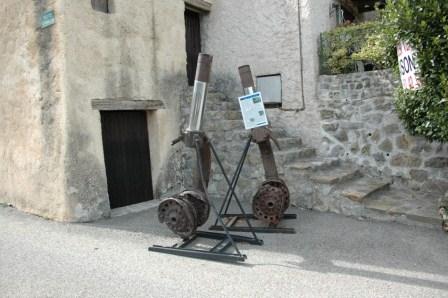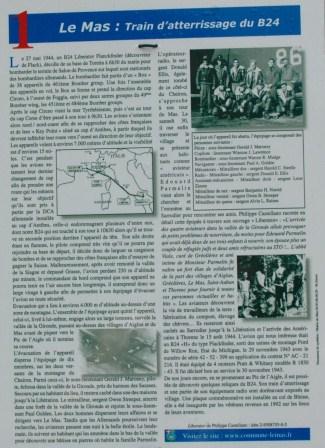B-24 (42-52399) 'Flak Finder' Memorial Objects
Details:
On the side of the street, beside a house. Commemorative Object
Monument Text:
Le Mas : Train d'atterrissage du B24
(1st Column)
Le 27 mai 1944, un B24 Liberator Flanckfinder (découvreur de Flack), décolle de sa base de Toretta à 6h30 du matin pour bombarder le terrain de Salon de Provence sur lequel sont stationnés des bombardiers allemands. Le bombardier fait partie d'un « Box » de 38 appareils du 461ème Bomber group. Une fois l'ensemble des appareils en vol, le Box se forme et prend la direction du cap Circeo, à l'ouest de Foggia. suivi par deux autres groupes du 49ème, Bomber wing, les 451ème et 484ème Bomber groups.
Après le cap Circeo vient la mer Tyrrhénienne, puis c'est au tour du cap Corse d'étre passé à son tour à 9h30. Les avions s'orientent alors nord / nord-ouest afin de se rapprocher des côtes françaises et de leu, « Key Point » situé au cap d'Antibes, à partir duquel ils devront infléchir leur route vers l'ouest en direction de leur objectif. Les appareils volent à environ 7.000 mètres d'altitude et la visibilité est d'environ 15 miles. C'est pendant que les avions entament leur dernier changement de cap afin de prendre une route qui les mènera sur leur objectif qu'ils sont pris à partie par la DCA allemande installée au cap d'Antibes, celle-ci endommageant plusieurs d'entre eux, dont notre B24 qui est touché à son tour à 10h30 alors qu'il se trouve en seconde position derrière l'appareil de tete. Son aile droite étant en flamme, le pilote comprend très vite qu'il ne pourra pas rejoindre sa base de départ, il décide donc de larguer sa cargaison de bombes et de se rapprocher des côtes françaises afin d'essayer de gagner la Suisse. Malheureusement, après avoir remonté la vallée de la Siagne et depassé Grasse, l'avion perdant 230 m d'altitude par minute, le commandant de bord comprend que son appareil ne pourra tenir en l'air encore bien longtemps, il entreprend donc un large virage à gauche afin de permettre à son équipage d'évacuer l'avion en toute sécurité.
Evacuation qui a lieu à environ 4.000 m d'altitude au-dessus d'une zone de montagne. L'ensemble de l'équipage ayant quitté l'appareil, celui-ci, livré à lui-même, engage alors un large tonneau, survole la vallée de la Gironde, passant au-dessus des villages d' Aiglun et du Mas avant de piquer vers le Pic de l'Aigle où il termine sa course. L'évacuation de l'appareil dispersa l'équipage de dix membres, sur les deux versants de la montagne du Cheiron. Parmi ceux-ci, le sous-lieutenant Gerald J. Mahoney, pilote échoua dans la vallée de la Gironde, près du hameau des Sausses. Secouru par un habitant du lieu, il restera caché dans une des maisons jusqu'à la Libération. Le mitrailleur, sergent Owen Streeper, atterit dans une forêt de la vallée de la Gironde et rejoint le sous-lieutenant Paul Golden. Les deux hommes dispersent leurs affaires et se dirigent vers Le Mas. Tandis que les Allemands poursuivent leur recherche, les aviateurs passent une nuit à la belle étoile. Le lendemain, ils suivent un habitant qui les emmène dans le bas de la vallée pour découvrir une bâtisse en pierres où habite la famille Parmelin.
(2nd Column)
L'opérateur-radio, le sergent Donald Ellis, également tombé de ce côté-ci du Cheiron, s'approche à son tour du Mas. Le samedi 30, il ose enfin traverser le village et se présente aux habitants comme « aviateur américain ». Edouard Parmelin vient alors le chercher et l'emmène au Sarrodier pour rencontrer ses amis. Philippe Castellano raconte en détail cette épopée à travers son ouvrage « Liberator » : « L'arrivée des quatre aviateurs dans la vallée de la Gironde allait provoquer de petits problèmes de nourriture, du moins pour Edouard Parmelin qui avait déjà deux de ses trois enfants à nourrir, son épouse plus un couple de réfugiés juifs et deux amis réfractaires au STO !... L'abbé Viale, curé de Gréolières et ami intime de Monsieur Parmelin fit naître un fort élan de solidarité de la part des villages d'Aiglun, Gréolières, Le Mas, Saint-Auban et Thorenc pour fournir à toute ces personnes victuailles et habits ». Les aviateurs découvrent la vie de travailleurs de la terre : fabrication du compost, élevage des chèvres... Ils resteront ainsi cachés au Sarrodier jusqu'à la Libération et l'arrivée des Américains à Thorenc le 15 août 1944. L'avion qui nous intéresse était un B24 «H» du type Flackfinder, sorti des usines de montage Ford de Willow Run, Etat du Michigan, le 29 novembre 1943 avec le numéro de série 42 - 52 - 399 en application du contrat N° AC - 21 216. Il était équipé de 4 moteurs Pratt & Whitney modèle R 1830 - 43. Il fut déclaré bon au service le 30 novembre 1943.
De nos jours encore, en se promenant au Pic de l'Aigle, il est possible de découvrir quelques reliques du B24. Son train d'atterrissage et une partie de son équipement radio sont dorénavant exposés au village. Une plaque commémorative est installée au col de Bleine, elle a été inaugurée par les vétérans revenus en 1992 sur les lieux de leurs aventures.
|
Le jour où l'appareil fut abattu, l'équipage se composait des personnes suivantes: Pilote : sous-lieutenant Gerald J. Maroney Copilote : lieutenant Winston J. Lawrence Bombardier : sous-lieutenant Warren R. Mudge Navigateur : sous-lieutenant Paul A. Golden Mécanicien : Mitrailleur dos : sergent Harold C. Steelle Radio - Mitrailleur gauche : sergent Donald E. Ellis Assistant-mécanicien - Mitrailleur droit : sergent Leon Zinner Mitrailleur de nez : sergent Benjamin H. Norrid Mitrailleur ventral : sergent Owen B. Streeper Mitrailleur de queue : sergent Alvin L. Raines |
English translation:
Le Mas: B24 Landing Gear
(1st Column)
On May 27, 1944, a B24 Liberator
Flackfinder took off from its base in Toretta at 6.30 a.m. to bomb the area of
Salon de Provence where German bombers were stationed. This bomber was part of
a "Box" of 38 aircraft from the 461st Bomber Group. Once all the
aircraft were in flight, the Box formed and headed for Cape Circeo, west of
Foggia, followed by two other groups from the 49th Bomber Wing, the 451st and
484th Bomber groups.
After Cape Circeo came the
Tyrrhenian Sea, then it was along Cape Corsica which was passed at 9:30 am. The
planes then oriented north / northwest in order to get closer to the French and
Leu coasts, "Key Point" located at Cap d'Antibes, from where they
turn their route west towards their objective . The aircraft flew at
approximately 7,000 meters above sea level and visibility was approximately 15
miles. It is while the planes begin their last change of course in order to
take a route which will lead them to their objective that they are taken to
task by the German DCA installed at Cap d'Antibes, this one damaging several of
them, including our B24 which is affected in turn at 10:30 am when it is in
second position behind the head unit. His right wing being in flames, the pilot
quickly understood that he could not reach his starting base, so he decided to
drop his cargo of bombs and get closer to the French coast in order to try to
reach Switzerland. Unfortunately, after going up the Siagne valley and passing
Grasse, the plane losing altitude of 230 m per minute, the captain understands
that his plane will not be able to stay aloft for very long, so he undertakes a
large left turn to allow its crew to safely evacuate the aircraft.
Evacuation takes place at around 4,000
m above a mountainous area. The entire crew having left the aircraft, it, left
to its own devices, flies over the Gironde valley, passing over the villages of
Aiglun and Le Mas before sting towards the Pic de l'Aigle where it ends its
course. The evacuation of the aircraft dispersed the crew of ten members, on
the two slopes of the Cheiron mountain. Among these, the Pilot, Second Lieutenant
Gerald J. Mahoney, landed in the Gironde valley, near the hamlet of Sausses.
Rescued by a local resident, he remained hidden in one of the houses until the
Liberation. The machine gunner, Sergeant Owen Streeper, landed in a forest in
the Gironde valley and joined Second Lieutenant Paul Golden. The two men
dispersed their belongings and headed for Le Mas. While the Germans continued
their search, the airmen spent a night under the stars. The next day, they
followed a resident who took them down the valley to find a stone building
where the Parmelin family lives.
(2nd Column)
The radio operator, Sergeant Donald
Ellis, who also fell on this side of the Cheiron, in turn approached the Mas.
On Saturday 30, he finally dared to cross the village and presented himself to
the inhabitants as "American aviator". Edouard Parmelin then came to
get him and took him to Sarrodier to meet his friends. Philippe Castellano retold
this epic in detail in book "Liberator": "The arrival of the
four aviators in the Gironde valley was going to cause small food problems, at
least for Edouard Parmelin who already had two of his three children at feed,
his wife plus a couple of Jewish refugees and two friends resistant to the STO!
... Father Viale, parish priest of Gréolières and close friend of Mr. Parmelin
gave rise to a strong surge of solidarity from the villages of Aiglun,
Gréolières, Le Mas, Saint-Auban and Thorenc to provide all these people with
food and clothes ”. The aviators discover the life of workers on the land:
making compost, raising goats ... They will thus remain hidden in Sarrodier
until the Liberation and the arrival of the Americans in Thorenc on August 15,
1944. The plane that interests us was a B24 "H" of the Flackfinder
type, released by the Ford assembly plants of Willow Run, State of Michigan, on
November 29, 1943 with the serial number 42 - 52 - 399 in application of contract
N ° AC - 21 216. It was equipped with four Pratt & Whitney model R 1830 -
43 engines. It was declared fit for service on November 30, 1943.
Even today, while walking at Pic de
l'Aigle, you can discover some relics of the B24. Its landing gear and some of
its radio equipment are now exhibited in the village. A commemorative plaque is
installed at the Col de Bleine, it was inaugurated by veterans who returned in
1992 to the places of their adventures.
(Photo caption)
|
On the day the aircraft was shot down, the crew consisted of following people: Pilot: Second Lieutenant Gerald J. Maroney Co-pilot: Lieutenant Winston J. Lawrence Bombardier: Second Lieutenant Warren R. Mudge Navigator: Second Lieutenant Paul A. Golden Mechanic: Back gunner: Sergeant Harold C. Steelle Radio - Left machine gunner: Sergeant Donald E. Ellis Assistant Mechanic - Right machine gunner: Sergeant Leon Zinner Nose gunner: Sergeant Benjamin H. Norrid Belly Gunner: Sergeant Owen B. Streeper Tail gunner: Sergeant Alvin L. Raines |
Commemorates:
People:
Units:
15th Air Force
461st Bomber Group
767th Bomber Squadron
United States Air Force
Wars:
WWII
Other images :


